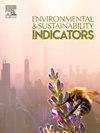Determinants of carbon dioxide emissions in technology revolution 5.0: New insights in Vietnam
IF 5.4
Q1 ENVIRONMENTAL SCIENCES
引用次数: 0
Abstract
This research investigates the determinants of carbon dioxide emissions within the context of Revolution 5.0, offering new insights specific to Vietnam. Understanding the environmental implications becomes imperative as the world undergoes unprecedented technological advancements. Data is collected in the World Bank from 2000 to 2023. The study used the random effect model- REM method, the Autoregressive Distributed Lag (ARDL) approach, which examines both short- and long-term relationships among the variables. The analysis of GDP sheds light on the nation's economic growth, emphasizing the sectors contributing significantly to this expansion and addressing associated challenges and opportunities. Migration patterns are explored to understand their impact on the workforce and demographics, considering influencing policies and factors. Population dynamics are scrutinized to reveal trends and factors affecting growth or decline, mainly the demographic dividend. Carbon dioxide emissions are investigated to comprehend their sources and contributors while exploring governmental initiatives aimed at environmental sustainability. The empirical results show that if Vietnam's gross domestic product is up by 1%, carbon dioxide emissions are down by 0.49%. If the Vietnam migration is up by 1%, carbon dioxide emissions are up by 2.11%. If the population is up by 1%, the carbon dioxide emissions are up by 14.62%. If Vietnam's renewable energy consumption is up by 1%, carbon dioxide emissions are down 0.388%. The study recognizes the interconnectedness of these factors, and the paper concludes by summarizing key insights and discussing their implications for Vietnam's future economic and environmental sustainability. Furthermore, it provides recommendations for policymakers and suggests avenues for future research to deepen our understanding of Vietnam's evolving socioeconomic landscape.
技术革命5.0中二氧化碳排放的决定因素:越南的新见解
本研究调查了5.0革命背景下二氧化碳排放的决定因素,为越南提供了新的见解。随着世界经历前所未有的技术进步,了解环境影响变得势在必行。数据由世界银行从2000年到2023年收集。该研究使用随机效应模型- REM方法,自回归分布滞后(ARDL)方法,该方法检查了变量之间的短期和长期关系。对GDP的分析揭示了国家的经济增长,强调了对经济增长做出重大贡献的部门,并解决了相关的挑战和机遇。探讨移民模式,以了解其对劳动力和人口统计的影响,考虑到影响政策和因素。对人口动态进行仔细研究,以揭示影响增长或下降的趋势和因素,主要是人口红利。研究二氧化碳排放,以了解其来源和贡献者,同时探索旨在环境可持续性的政府举措。实证结果表明,越南国内生产总值每增长1%,二氧化碳排放量就会下降0.49%。如果越南移民增加1%,二氧化碳排放量就会增加2.11%。人口每增加1%,二氧化碳排放量就会增加14.62%。越南的可再生能源消费每增长1%,二氧化碳排放量就会下降0.388%。该研究认识到这些因素之间的相互联系,论文总结了关键见解,并讨论了它们对越南未来经济和环境可持续性的影响。此外,它为政策制定者提供了建议,并为未来的研究提供了途径,以加深我们对越南不断变化的社会经济格局的理解。
本文章由计算机程序翻译,如有差异,请以英文原文为准。
求助全文
约1分钟内获得全文
求助全文
来源期刊

Environmental and Sustainability Indicators
Environmental Science-Environmental Science (miscellaneous)
CiteScore
7.80
自引率
2.30%
发文量
49
审稿时长
57 days
 求助内容:
求助内容: 应助结果提醒方式:
应助结果提醒方式:


